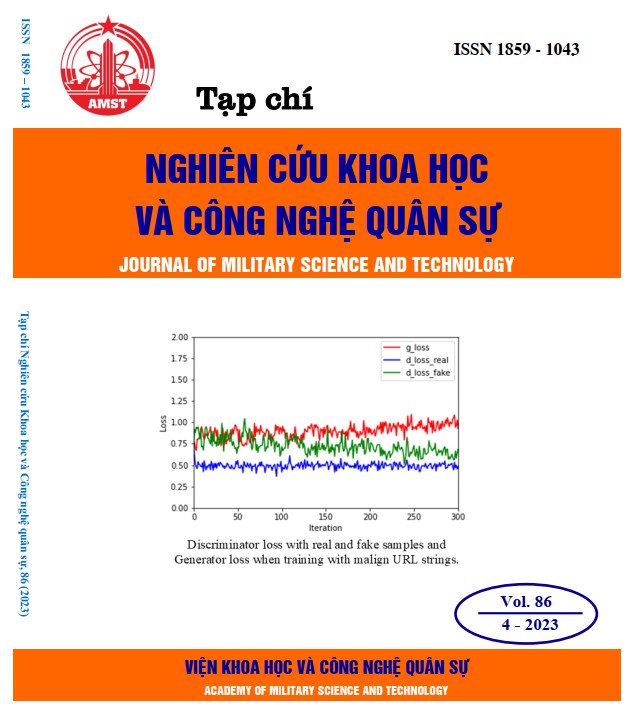Removal of color and COD from textile wastewater using a combination of AOPS/UV and coagulation pre-treatment
633 viewsDOI:
https://doi.org/10.54939/1859-1043.j.mst.86.2023.86-94Keywords:
Textile wastewater; Coagulation; AOPs/UV; H2O2/UV; S2O82-/UV; O3/UV; Color removal; COD removal.Abstract
In this study, COD and color in textile dyeing wastewater were treated with the Ultraviolet-based Advanced Oxidation Processes (AOPs/UV) combined with a coagulation pretreatment. The results showed that the primary coagulation treatment can remove 49% COD (432 mg/L) and 50% color (465 Pt-Co). The secondary treatment by the AOPs/UV using ozone (O3) as oxidizing agent was found to be the most effective with removal efficiency COD and color were 96% (32 mg/L) and 95% (45 Pt-Co), respectively which can meet the highest discharge standards of current textile dyeing industry wastewater. While the AOPs/UV using S2O82- and H2O2 as oxidizing agents showed the COD removal efficiencies were 84% (134 mg/L) and 75% (214 mg/L) as well as the decolorization efficiencies were 75% (214 mg/L) and 85% (127 Pt-Co), respectively. These findings can be expected as technological orientation for design of treatment systems using different approaches from traditional ones such as microbiological and physico-chemical treatment systems. The AOPs/UV solution combined with coagulation pretreatment, therefore, can be an effective method applied to treat the COD and decolorization in the textile dyeing wastewater.
References
[1]. Hutagalung, S.S., et al., "Textile Wastewater Treatment using Advanced Oxidation Process (AOP)". IOP Conference Series: Materials Science and Engineering, Vol. 722, pp. 1-9, (2020). DOI: https://doi.org/10.1088/1757-899X/722/1/012032
[2]. Yonar, T. and M.Y. Kilic, "Chemical oxygen demand and color removal from textile wastewater by UV/H2O2 using artificial neural networks". Water Environ Res, Vol. 86, No. 11, pp. 2159-2165, (2014). DOI: https://doi.org/10.2175/106143014X14062131178277
[3]. Ramos, P.B., et al., "Treatment of real non-biodegradable wastewater: Feasibility analysis of a zero-valent iron/H2O2 process". Journal of Environmental Chemical Engineering, Vol. 8, No. 4, pp. 103954, (2020). DOI: https://doi.org/10.1016/j.jece.2020.103954
[4]. Dinçer, A.R., "Increasing BOD5/COD ratio of non-biodegradable compound (reactive black 5) with ozone and catalase enzyme combination". SN Applied Sciences, Vol. 2, No. 4, pp. 1-10, (2020). DOI: https://doi.org/10.1007/s42452-020-2557-y
[5]. Quyen, V. and X.-T. Bui, "Removal of Non-Biodegradable Organic Matters from Membrane Bioreactor Permeate By Oxidation Processes", pp. 13-23. (2011).
[6]. Anh, N.T., et al., "Xử lý nước thải dệt nhuộm bằng quá trình oxy hoá bậc cao kết hợp với UV". Journal of science of Lac Hong university, Vol. 9, pp. 47-52, (2020).
[7]. Suryawan, I.W.K., et al., "Laboratory scale ozone-based post-treatment from textile wastewater treatment plant effluent for water reuse". Journal of Physics: Conference Series, Vol. 1456, No. 1, (2020). DOI: https://doi.org/10.1088/1742-6596/1456/1/012002
[8]. Wantoputri, N.I., et al., "Reactive Black-5 Removal by Ozonation as Post Treatment". IOP Conference Series: Materials Science and Engineering, Vol. 536, No. 1, pp. 1-7, (2019). DOI: https://doi.org/10.1088/1757-899X/536/1/012069
[9]. Baird, R.B., et al., 2120 Color, in Standard Methods For the Examination of Water and Wastewater. American Public Health Association, (2018).
[10]. Baird, R.B., et al., 2130 Turbidity, in Standard Methods For the Examination of Water and Wastewater. American Public Health Association, (2018).
[11]. Baird, R.B., et al., 4500-H pH, in Standard Methods For the Examination of Water and Wastewater. American Public Health Association, (2018).
[12]. Baird, R.B., et al., 5220 Chemical oxygen demand (COD), in Standard Methods For the Examination of Water and Wastewater. American Public Health Association, (2018).
[13]. Turan-Ertas, T., "Biological and Physical-Chemical Treatment of Textile Dyeing Wastewater for Color and COD Removal". Ozone: Science & Engineering, Vol. 23, No. 3, pp. 199-206, (2001). DOI: https://doi.org/10.1080/01919510108962003
[14]. Karam, A., et al., "Coagulation/flocculation process for textile mill effluent treatment: experimental and numerical perspectives". International Journal of Sustainable Engineering, Vol. 14, No. 5, pp. 983-995, (2021). DOI: https://doi.org/10.1080/19397038.2020.1842547
[15]. Color and COD removal from textile waste water containing reactive dyes using coagulation and fenton’s oxidation, in The potential health and environmental impacts of exposure to hazardous natural and man-made chemicals and their proper management, (2012).
[16]. Guida, M., et al., "Optimization of Alum-coagulation/flocculation for COD and TSS removal from five municipal wastewater". Desalination, Vol. 211, No. 1, pp. 113-127, (2007). DOI: https://doi.org/10.1016/j.desal.2006.02.086
[17]. Safarikova, J., et al., "Influence of peptides and proteins produced by cyanobacterium Microcystis aeruginosa on the coagulation of turbid waters". Separation and Purification Technology, Vol. 118, pp. 49-57, (2013). DOI: https://doi.org/10.1016/j.seppur.2013.06.049
[18]. Pourgholi, M., et al., "Removal of Dye and COD from Textile Wastewater Using AOP (UV/O3, UV/H2O2, O3/H2O2 and UV/H2O2/O3)". Journal of Environmental Health and Sustainable Development, Vol. 3, pp. 621-629, (2018). DOI: https://doi.org/10.18502/jehsd.v3i4.223
[19]. Mounteer, A.H., et al., "Removing textile mill effluent recalcitrant COD and toxicity using the H2O2/UV system". Water Sci Technol, Vol. 60, No. 7, pp. 1895-1902, (2009). DOI: https://doi.org/10.2166/wst.2009.584
[20]. Wang, C.-W. and C. Liang, "Oxidative degradation of TMAH solution with UV persulfate activation". Chemical Engineering Journal, Vol. 254, pp. 472-478, (2014). DOI: https://doi.org/10.1016/j.cej.2014.05.116
[21]. Rezaee, A., et al., "Photochemical oxidation of Reactive Blue 19 Dye (RB19) in textile wastewater by UV/K2S2O8 process". Iranian Journal of Environmental Health, Science and Engineering, Vol. 5, pp. 95-100, (2008). DOI: https://doi.org/10.3923/jas.2008.1108.1112
[22]. Bộ Tài Nguyên Và Môi Trường, QCVN 13:2015/BTNMT - Quy chuẩn kỹ thuật quốc gia về nước thải công nghiệp dệt nhuộm, (2015).







